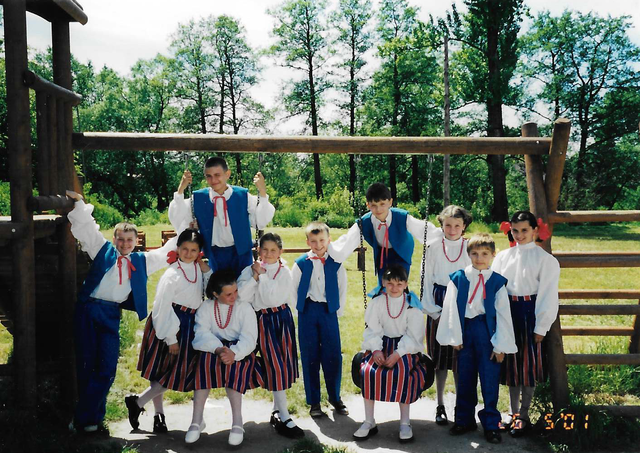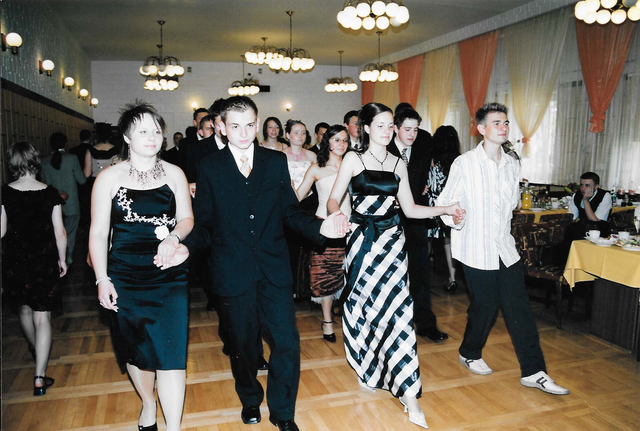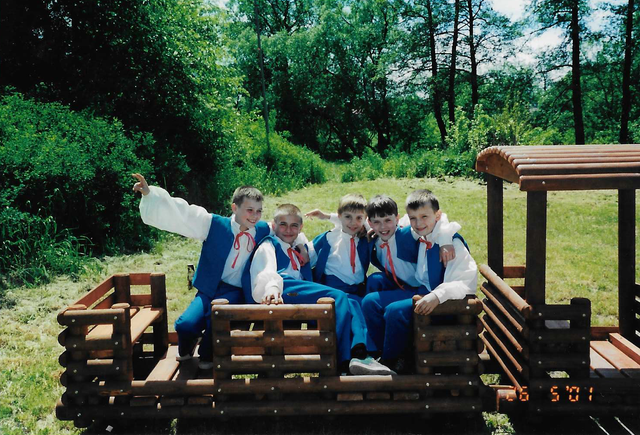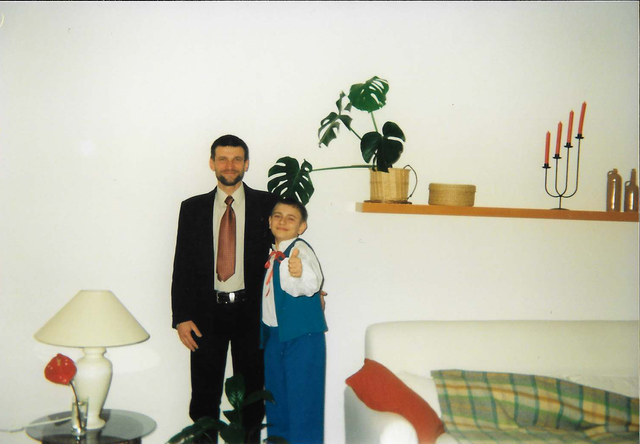Traditional Polish dances
The most important Polish dances
 little papi.mati with his traditional dancers group (second from the left, on the swing)
little papi.mati with his traditional dancers group (second from the left, on the swing)Today I am going to tell you about some of the most important traditional Polish dances. Of course, it is impossible to exhaust the topic in one post, so I had to choose a few dances that I found the most interesting. Each region, and sometimes even a separate village or city, has its dances. Moreover, the dances differed in the villages, and at the courts of rulers. For me, the most important are the rural ones, which in some cases have stood the test of time and are still danced at parties in a slightly changed form.
I am a little less interested in stage dances, but still, pay special attention to them. As a child, I belonged to a traditional dance group and I danced some of them (in fact, I learned about four dances: Polonez, Trojak, Oberek, and Krakowiak). Unfortunately, some of these have survived our times in a slightly different form. They are artificial. They are glamorous and beautiful, but there is no vivid spontaneity in them - nobody dances them anymore behind the barn, at a wedding, or a birthday party - they only have the right to be present at festivals and stage shows. This makes me pay less attention to them because in dances and traditions I always look for authenticity.
Chodzony/Polonez
 Me as the teenager (right side), dancing Polonez after finishing second grade school (before the high-school)
Me as the teenager (right side), dancing Polonez after finishing second grade school (before the high-school) It comes from the 16th century and is danced everywhere, all over Poland. It had its country version ("Chodzony", from "Chodzić" - walking) and court, noble ("Polonez" or "Polonaise" from "Polska" - Poland). In the past, it was most often danced during wedding ceremonies. The steps and figures are quite simple, you can learn them without any problems. Moreover, the figures depend on the first two, or sometimes four pairs, so while dancing as one of the last pairs, it was enough to follow the steps suggested by the leaders.
The order of dancing depended on the hierarchy in the community. The first pairs were reserved for the most respected and influential, while the last ones were the youngest and least significant.
The pace for three. One long step, then two short steps. The dance was danced in pairs, with the woman on the right and the man on the left.
The dance has survived our times in an unchanged form. It is a tradition that it is danced at the beginning of every prom at school. It’s an opening dance, obligatory for all the students and teachers. Then, a regular modern party starts. It is also often danced at important state ceremonies, holidays, and other national events.
Krakowiak
 Me with my friends in Krakowiak costumes
Me with my friends in Krakowiak costumes A very old parade dance, also associated with the hierarchy in the order of pairs. Everyone knew how to dance it, but there were many figures and their order and selection depended on the first pair. It had several characters and names depending on the region ("Mijany", "Dreptany", "Przebiegany"). The main name comes from Cracov, a city in Poland.
Krakowiak was widespread in south-eastern Poland, from Lesser Poland to the Lublin region, and even reaching western Ukraine and Belarus. Usually danced at weddings and important occasions, however, with time it began to disappear and now it appears only in the form of a stage, at festivals and other reviews of traditional dances. Nobody dances the Krakowiak in contemporary villages. Perhaps this is because in the 19th century the Polka appeared - a dance that very quickly spread throughout Poland and even Europe. The Polka was danced to the same meter, so the old pieces of the Krakowiak were used to dance the new dance and the world forgot about the Krakowiak.
Krakowiaks in distant villages are still played, but not danced anymore. Music is played during weddings as the procession travels from home to church.
Polka
The name "Polka" comes from the word "półka", that is, a half. In the nineteenth century, the dance made a huge furor and spread to the entire territory of Poland and Europe. It began to be danced everywhere. It became so popular that it absorbed the Krakowiak. It was most popular in the Subcarpathian region and in the Rzeszów region, where over a dozen varieties of this dance were known.
Interestingly, the Polish origin of the dance is not so certain. Ethnographers argue with each other and many of them point to the probable origins of the dance from the Czech Republic. Even if originally Polka is Czech, in Poland it became a national dance very quickly and with great success.
Polka, together with Mazurek and Habanera, gave rise to early versions of Tango, such as Tango Milonga.
PS: the guy with the violin on the video below is my husband. That's the Polka impro on the streets of Kraków.
Zbójnicki dance
Zbójnicki (Thief) dance is quite original compared to the rest of the Polish dances. The man often does not touch his partner but chases her, dances around her, often have no direct contact. This is due to the much more conservative highlander culture. Pay attention to the dynamics of the dance and costumes - it differs significantly from all other dances presented in this post because the southern, mountainous areas of Poland were strongly separated from the rest of the country and created a very distinct culture (which can be seen not only in dances but also singing, costumes, architecture or art).
Oberek and Mazurek
Oberek is Mazurek's younger brother, but sometime in the 1960s and 1970s, the difference between them was completely blurred and now they are considered to be one dance under two different names. Oberek is a name derived from "Obroty", that is, to turn. "Mazurek" is the name of the region of Mazovia.
These dances are no longer processional, they are danced in pairs, quite quickly. Couples dance in a circle, sometimes with commands - to a wall, in a circle, vice versa - so that there is an interaction between the couples to not disturb each other. If you didn't know the basic commands, you could be thrown out of the dance, so getting started dancing required some preparation.
The dance had an inducing effect on the trance. In the villages, oberek was often danced for several hours without a break. Fast turning in a circle and around its axis gave a feeling of intoxication like drugs, a slightly hypnotic state.
Everything is allowed in Oberek - usually, pairs were male and female, but it happened that two women or two men danced with each other.
It's still very present in the villages and sometimes even cities.
Kujawiak
A very old dance from Kuyavia - the name of the dance appears for the first time at the beginning of the 19th century, but ethnographers agree that the dance was known much earlier, most likely from the 15th century. Dignified, associated with weddings, like most dances that have survived to this day. It has a three-quarter meter, it is a quiet dance, not very dynamic and slow. It was usually performed with chants. It relied on a gentle gait and turns with stamps on accents.
Currently, it has been preserved mainly as a stage dance. It is rather absent in the villages.
Wiwat
Greater Poland Dance. Young people are still dancing Wiwat at discos in the countryside. Danced for the tempo of 2/3. It is characterized by a lively pace and the possibility of improvisation. It consisted of two forms - first shifting from foot to foot in place, and then spinning quickly around its axis.
Olender
Kurpie dance, brought from the Netherlands. Quite similar to Oberek, but less fast.
Krzyżak and Kontro
The Krzyżak is the country version, and the Kontro is the court version. The dances were often intertwined, everyone was watching everyone and drawing inspiration from each other, hence the two versions of the same dance. Simple to learn, and at the same time fun, highly recreational. It is not that exhausting, so it was often a form of rest after quick obereks.
Trojak
A slow, simplified Krakowiak danced in three - usually a man with two women. In this region (Silesia), when the gentlemen went to the mine to work, many women stayed upstairs, so the peasant often took his mother and wife and danced in three.
It's one of the first traditional dances we learn. Most kindergartens teach kids how to perform Trojak.
Czardas
A dance that came to Poland from Hungary. Hungarian influences can be seen in the costumes and the nature of the dance. Most often danced by the Gypsies present in Poland.
Hajduk
The dance came from the south. It sounds completely different than the typically Polish ones, from the center of the country. It is a highlander, spectacular dance, with elements danced in pairs as well as fragments of typically male or female dances. It performed in a form interspersed with chants. Most present in the Żywiec region.
Thumb up from little me and my dad!

This dance looks so interesting.....
thank you :)
Hola @papi.mati que maravillosa despliegue de bailarines y bailarinas acompañados de la orquesta, la Polka bailada en compañía de la sencillez del pandero y el acordeón. Disfrutamos conocer a través de ti de la Cultura Polaca.
Gracias por ser parte de Recreative Steem.